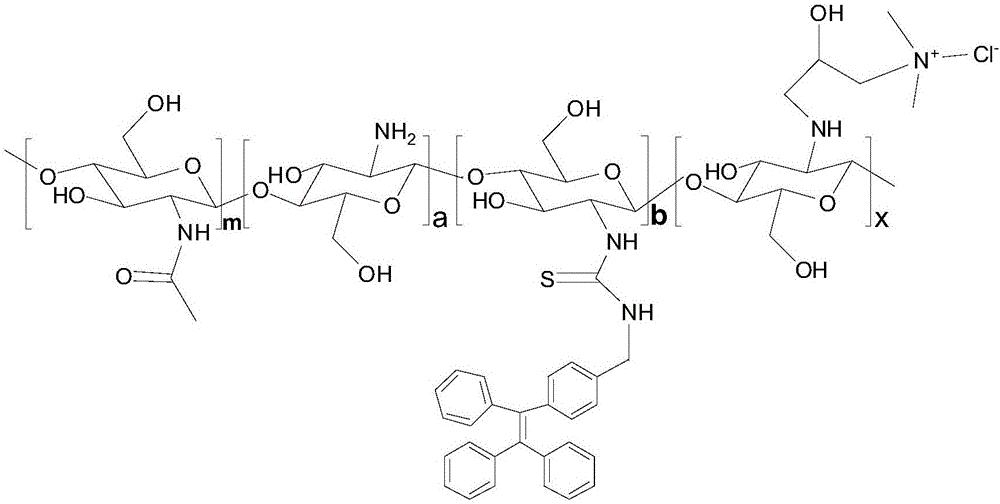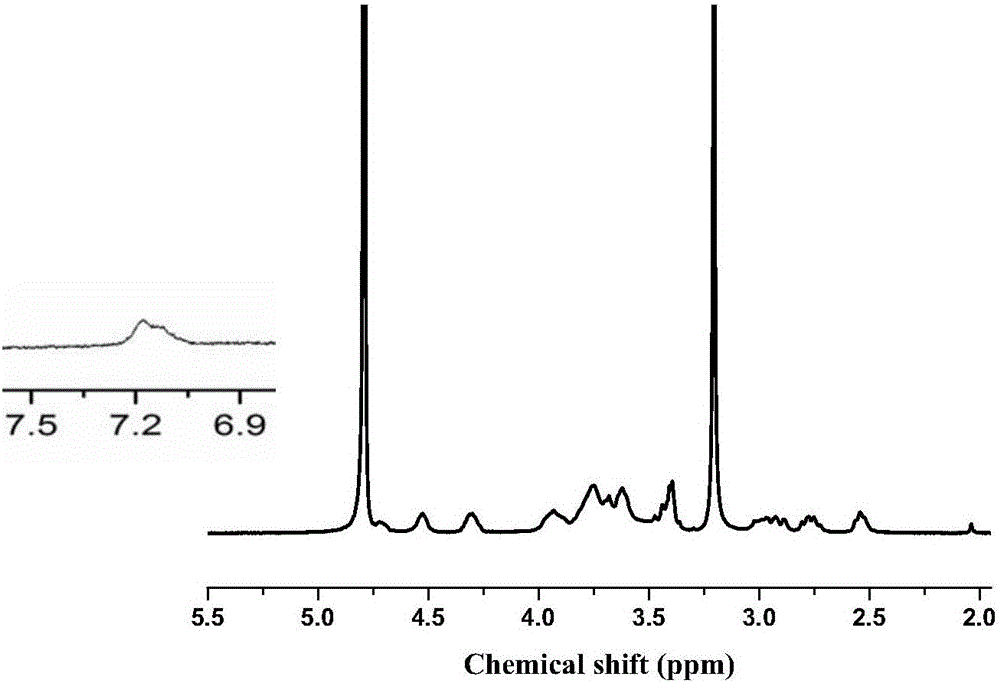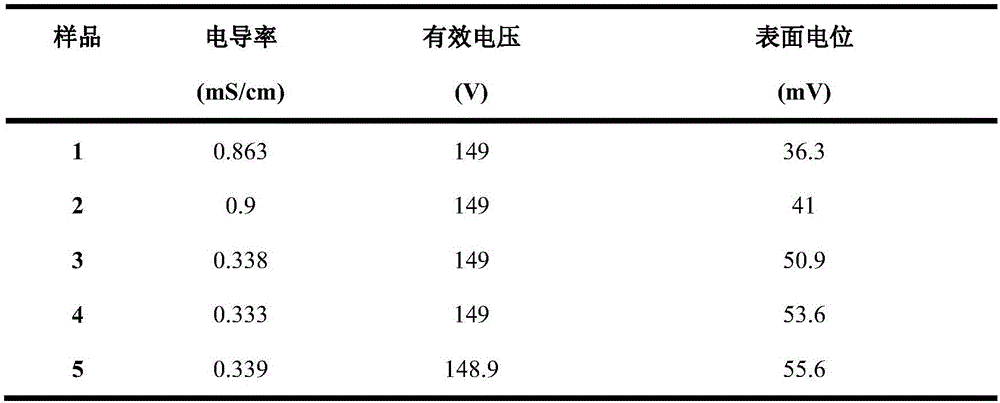Quaternized chitosan fluorescent probe with aggregation-induced emission property and preparation method thereof
A technology of quaternized chitosan and aggregation-induced luminescence, which is applied in chemical instruments and methods, luminescent materials, fluorescence/phosphorescence, etc., can solve the problems of dye leakage, cytotoxicity, etc., and achieve excellent water solubility, fluorescence spectrum does not drift, Good biocompatibility effect
- Summary
- Abstract
- Description
- Claims
- Application Information
AI Technical Summary
Problems solved by technology
Method used
Image
Examples
Embodiment 1
[0020] 1) Take by weighing 1g chitosan (viscosity-average molecular weight is 10,000, degree of deacetylation 60%) joins in the flask of 50ml, add 20ml volume fraction and be 1% acetic acid solution, stir and dissolve, obtain chitosan concentration and be 50mg / mL of solution A;
[0021] 2) Take 0.453ml of 2,3-epoxypropyltrimethylammonium chloride, add the same volume of triple distilled water, and prepare solution B;
[0022] 3) Warm up solution A to 45°C, drop solution B into solution A, make the molar ratio of GTA to amino groups in chitosan 1:1, react for 6 hours, and obtain solution C;
[0023] 4) Solution C is packed into a dialysis bag with a molecular weight cut-off of 3500 and placed in three-distilled water for dialysis for 2 days, and freeze-dried to obtain water-soluble quaternized chitosan TMC;
[0024] 5) Weigh 0.1g of TMC obtained in step 4) and disperse it in 10ml of DMSO, swell at 50°C for 10h, then add 1mg of TPEITC to the solution to make the mole of amino ...
Embodiment 2
[0029] 1) Take by weighing 1g chitosan (viscosity-average molecular weight is 190,000, deacetylation degree 68%) joins in the flask of 50ml, add 25ml volume fraction and be 1% acetic acid solution, stir and dissolve, obtain chitosan concentration and be 40mg / mL of solution A;
[0030] 2) Take 0.785ml of 2,3-epoxypropyltrimethylammonium chloride, add the same volume of triple distilled water, and prepare solution B;
[0031] 3) The temperature of solution A was raised to 55° C., and solution B was slowly added dropwise into solution A, so that the molar ratio of GTA to chitosan amino groups was 1.5:1, and reacted for 6 hours to obtain solution C;
[0032] 4) Solution C is packed into a dialysis bag with a molecular weight cut-off of 8000 and placed in three-distilled water for dialysis for 3 days, and freeze-dried to obtain water-soluble quaternized chitosan TMC;
[0033] 5) Weigh 0.1g of TMC obtained in step 4) and disperse it in 10ml of DMSO, swell at 55°C for 8h, then add ...
Embodiment 3
[0038] 1) Take by weighing 1g chitosan (viscosity-average molecular weight is 530,000, degree of deacetylation 74.5%) joins in the flask of 100ml, add 50ml volume fraction and be 1.5% acetic acid solution, stir and dissolve, obtain chitosan concentration and be 20mg / mL of solution A;
[0039] 2) Take 1.164ml of 2,3-epoxypropyltrimethylammonium chloride, add the same volume of triple distilled water, and prepare solution B;
[0040] 3) Warm up solution A to 65°C, drop solution B into solution A so that the molar ratio of GTA to amino groups in chitosan is 2:1, and react for 15 hours to obtain solution C;
[0041] 4) The solution C is packed into a dialysis bag with a molecular weight cut-off of 14000 and placed in three-distilled water for dialysis for 3 days, and freeze-dried to obtain water-soluble quaternized chitosan TMC;
[0042] 5) Weigh 0.1g of TMC obtained in step 4) and disperse it in 10ml of DMSO, swell at 60°C for 8h, then add 6.6mg of TPEITC to the solution to mak...
PUM
| Property | Measurement | Unit |
|---|---|---|
| concentration | aaaaa | aaaaa |
| concentration | aaaaa | aaaaa |
Abstract
Description
Claims
Application Information
 Login to View More
Login to View More - R&D
- Intellectual Property
- Life Sciences
- Materials
- Tech Scout
- Unparalleled Data Quality
- Higher Quality Content
- 60% Fewer Hallucinations
Browse by: Latest US Patents, China's latest patents, Technical Efficacy Thesaurus, Application Domain, Technology Topic, Popular Technical Reports.
© 2025 PatSnap. All rights reserved.Legal|Privacy policy|Modern Slavery Act Transparency Statement|Sitemap|About US| Contact US: help@patsnap.com



